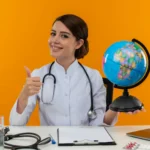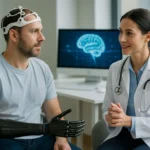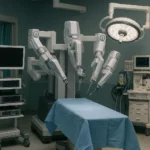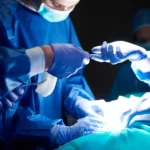Lung Regeneration Therapy for COPD & Lung Diseases
Lungs, essential for every breath, are vulnerable to diseases like COPD and pulmonary fibrosis, which have severely impacted millions in recent decades. Traditional treatments focus on managing symptoms and slowing progression, but rarely on reversing damage. However, advancements in lung regeneration are now within reach. Stem cell therapy and gene editing offer hope to rebuild damaged lung tissues and provide new treatment possibilities for previously irreversible conditions.
This article explores medical breakthroughs in treating COPD, interstitial lung disease, and other respiratory conditions, along with tips for preventing and improving lung health.
Understanding the Challenge: COPD & Pulmonary Fibrosis Today
Chronic obstructive pulmonary disease (COPD) is a condition associated with chronic lung inflammation due to emphysema and chronic bronchitis resulting in narrowing airways, excessive mucus and destruction of lung tissue. Patients get breathlessness, chronic cough and extreme tiredness.
Pulmonary fibrosis is also so-called classified as an interstitial lung disease, which mainly refers to scarring of the lung tissue, thus stiffening it and causing it to malfunction in its primary function, which is the exchange of oxygen. The two conditions cripple any patient entirely, almost making his or her life totally limited.
Present treatments for COPD include bronchodilators, corticosteroids, oxygen therapy, and finally, lung transplantations as a last option. The damage caused such, however, is not reversible. Therefore, researchers have turned to regenerative medicine for answers.
What Is Lung Regeneration? A New Frontier in Respiratory Medicine
Lung regeneration refers to the medical approach aimed at repairing and restoring damaged lung tissues due to disease or injury. While conventional treatment approaches focus on symptom alleviation, regenerative therapies aspire to actually reverse damage.
This process can encompass the following techniques: stem cell therapy, gene therapy, and organoids—miniature, simplified versions of organs cultured in the laboratory from human cells. The desired result? To bring back normal structure and function to lungs, mitigate inflammation and give new life to the patients.
a) Innovations Leading the Way in Lung Regeneration
Let’s see how science is redefining and offering new dreams to patients afflicted with chronic respiratory system disorders.
Stem Cell Therapy: Rebuilding from Within
Stem cell therapy could be the most promising therapeutic avenue available in lung disease. Scientists use mesenchymal stem cells (MSCs), or i-induced pluripotent stem cells (iPSCs). These can transform into a variety of lung cells and have been known in the treatment of chronic obstructive pulmonary disease (COPD) or those having interstitial lung disease, where such cells can:
- Reduce inflammation in the respiratory system
- Regenerate and repair damaged alveoli (tiny air sacs in lungs)
- Improve lung functioning with reduced flares
Encouraging results have been demonstrated in clinical trials. Such as, patients receiving stem cell infusion showed improved oxygenation and fewer hospital visits. Though still being studied, such therapy has the potential to be transformational in the field of pulmonology diseases.
b) Gene Therapy: Rewriting Lung Health at the Molecular Level
Gene therapies represent yet another major weapon in development focusing specifically on the root causes of diseases, abnormal genes or misbehaving genes that lead to unusual behavior of tissues.
In pulmonary fibrosis, a profusion of genes triggers excessive scar tissue formation. Hence, with technologies such as CRISPR, those abnormalities can be turned off, potentially halting further destruction. In the future, gene therapy may also have a role in aiding COPD patients by restoring inflammation and tissue repairing capacities.
The excitement for gene therapy is still in the more experimental stage concerning pulmonary diseases, which gives even more expressiveness to the potential of DNA Given damage or repair by the gene-editing system.
c) Organoids and Lung-on-a-Chip Models
Picture growing a tiny lung on a chip or in a petri dish. Strange, right? But it is already happening.
Organoids, miniature lungs developed from cells derived from patients, have been used for drug screening, disease progression and patient-specific therapy. Similarly, human lung tissue is replicated using lung-on-a-chip models in which pathophysiological behaviors occur that are more apparent than any animal model.
These findings help understand the pathogenesis of lung diseases such as chronic obstructive pulmonary disease and interstitial lung disease, as well as the interaction of hypothesis therapies with real human tissue.
Real-World Applications: What’s Working Today?
These futuristic treatments are not theories anymore; they are already in trials in the real sense.
Some clinical trials are now being done all over the world, especially in the USA, Europe and some parts of Asia. Results in the early phase of trials with stem cell therapy for COPD patients show significant therapeutic benefits, like reducing inflammation, increasing breathing capacity and sometimes even regenerating tissue.
Likewise, bioengineered scaffolds implanted into animals have supported the growth of lung-like tissue. These results have opened the door for possible future human applications, especially for patients with advanced respiratory diseases that do not benefit from conventional treatment.
Challenges & Ethical Considerations in Lung Regeneration
While the possibilities are exciting, there are significant hurdles to overcome:
- Safety and Side Effects: Long-term effects of gene therapy or stem cell therapy are not fully understood.
- Ethical Dilemmas: Gene editing, especially in unborn children or embryos, raises moral questions.
- Affordability: Advanced therapies are expensive and not accessible to all.
- Regulation and Approval: Each innovation must pass strict safety and ethical checks before becoming available to patients.
Despite these challenges, the momentum continues, fueled by increasing funding and collaboration across the globe.
How to Check Lung Health: Early Detection Is Key
But in the meantime, keep track of your current lung health. Here are some ways you can do this:
- Spirometry Test: it measures how much air you can exhale and how fast.
- Chest X-rays or CT scans: find early signs of interstitial lung disease or scarring.
- A Pulse Oximeter is a small device that checks for oxygen saturation levels in your blood.
- 6-Minute Walk Test: It gauges how well the lungs provide oxygen during activity.
But if you feel short of breath, cough frequently, or just tire too easily, don’t brush it off. Early diagnosis means a better outcome.
How to Improve Lung Health: Practical Tips
Medical innovations are changing every day, but do not underestimate everyday choices that go a long way in preserving the health of your respiratory system:
- Quit Smoking: This is an important lung cancer and COPD cause.
- Avoid Pollutants: A mask can mitigate the effects of dust or pollution in the environment.
- Exercise Regularly: Walking, swimming, or yoga increases your ability to breathe.
- Eat Lung Foods: This consists of green vegetables, berries, and antioxidant-rich foods that may help in counteracting inflammation.
- Practice Breathing Exercises: Pursed-lip breathing helps recuperate lung function.
Small acts today for healthy lungs tomorrow.
Why Choose India for Lung Regeneration and Treatment?
- In World-Class Pulmonologists: India is home to globally recognised experts in pulmonology diseases, respiratory diseases and regenerative therapies.
- Advanced Hospitals: Equipped with cutting-edge technologies for stem cell therapy, gene therapy and organoid-based research.
- Cost-Effective Care: Patients receive high-quality treatment at a fraction of the cost compared to the USA, UK or Europe.
- Innovative Clinical Trials: India leads in global trials for COPD treatment, lung regeneration and advanced diagnostics.
- Global Medical Hub: International patients choose India for trusted, affordable and advanced healthcare services.
Why Choose Regimen Healthcare for Lung Regeneration?
- Personalised Support: Regimen offers end-to-end care tailored to your condition from consultation to recovery.
- Access to Top Doctors: We work directly with India’s best specialists in lung disease, COPD and regenerative medicine.
- Visa & Travel Assistance: Full support with medical visa processing, flight booking, and local transport.
- Comfortable Stays: Help with hotel bookings, guest houses near hospitals, and interpreter services.
- Multilingual Communication: Our team speaks your language—making everything easy to understand.
- 24/7 Patient Support: You are never alone, we are available throughout your journey for updates, help and care coordination.
Conclusion: A Breath of Hope
We have now entered the era of revolutionizing lung health with regenerative medicine from stem cells, refined by gene therapy and visualised in organoids. Conditions such as COPD and pulmonary fibrosis would no longer see management but undergo repair and renewal.
Discovery speed is promising; however, some hurdles exist but the future is not enduring but living with the disease of the lungs. It is living full breaths minus a legacy from the past.
Whether you are a patient, a caregiver, or just someone who cares to know about the new field of pulmonology, it is high time you start paying attention to this. Pretty soon, the atmosphere will fill not just with oxygen, but also with hope.
Well, if you or your loved one has ended up getting COPD, pulmonary fibrosis, or any other disorder of the respiratory tract, do not wait until the symptoms get very bad. The future of lung health has arrived-it is time to take action.
💬Contact Regimen Healthcare for the latest treatments, counsels from experts, and an impromptu plan for living with healing and hope.
📞 Call or WhatsApp us at +91-9310356465
🌐 Visit our website: www.regimenhealthcare.com
Breathe better. Live better. Choose Regimen.
Frequently Asked Questions (FAQs)
1. What is lung regeneration?
It’s a medical approach to repair or regrow damaged lung tissue using stem cell therapy, gene therapy, and organoids.
2. Can stem cell therapy treat COPD?
Yes, it can reduce inflammation, promote healing, and improve lung function in COPD, but it’s still under research.
3. What are organoids used for?
Organoids are lab-grown mini lungs used to study diseases and test treatments for personalized care.
4. Is gene therapy available for lung disease?
Not widely yet. But trials for gene therapy in pulmonary fibrosis and COPD show promising early results.
5. How can I check my lung health?
With tests like spirometry, CT scans, pulse oximetry, or a 6-minute walk test. Early checks help catch respiratory diseases early.
6. What are early symptoms of COPD?
Shortness of breath, chronic cough, wheezing, and frequent infections are key signs of chronic obstructive pulmonary disease.
7. Can lung damage be reversed?
Some damage may be reversed through lung regeneration, especially if detected early and treated with modern therapies.






